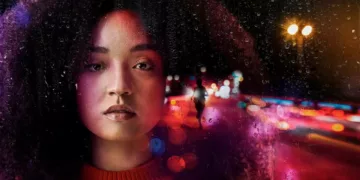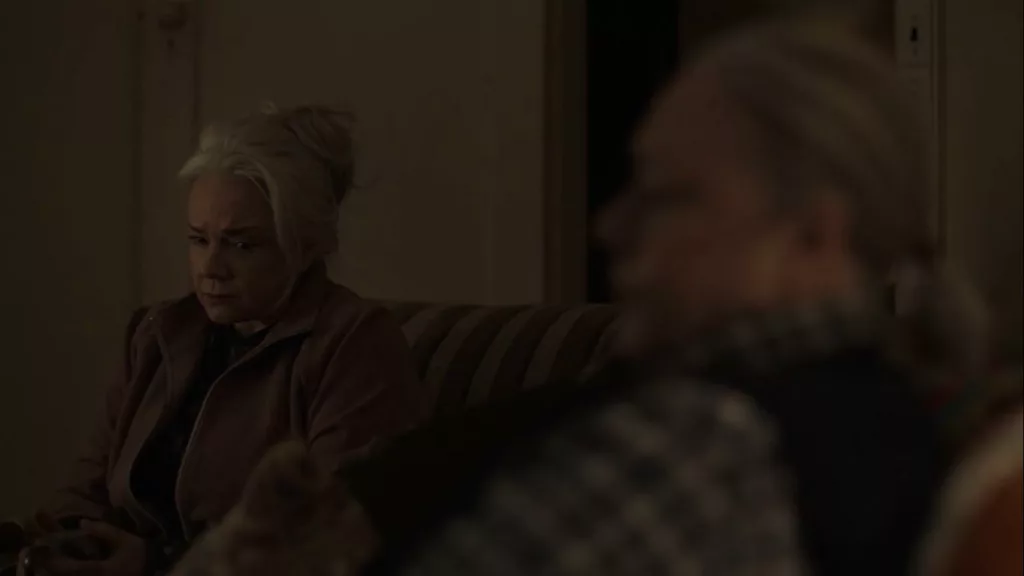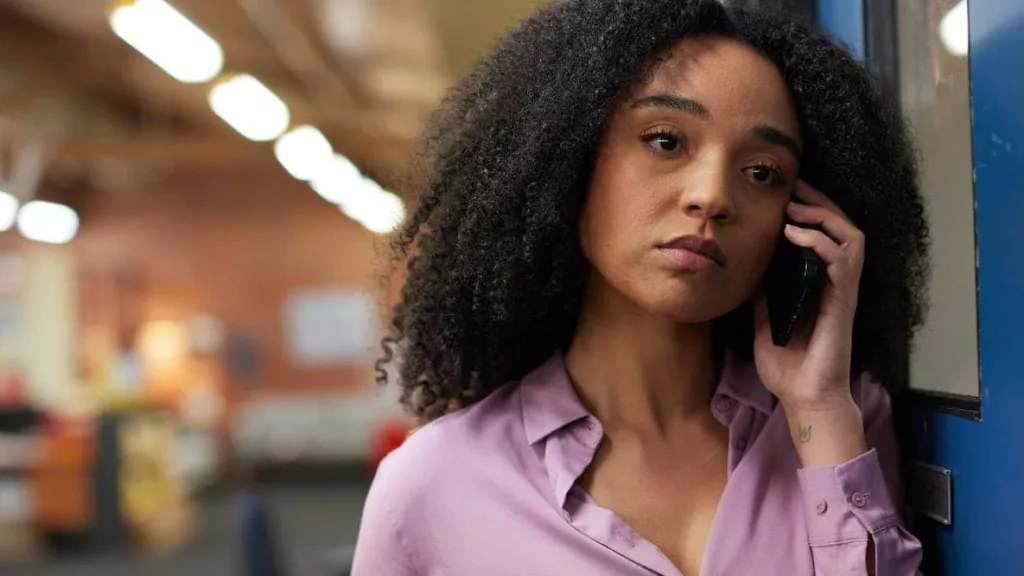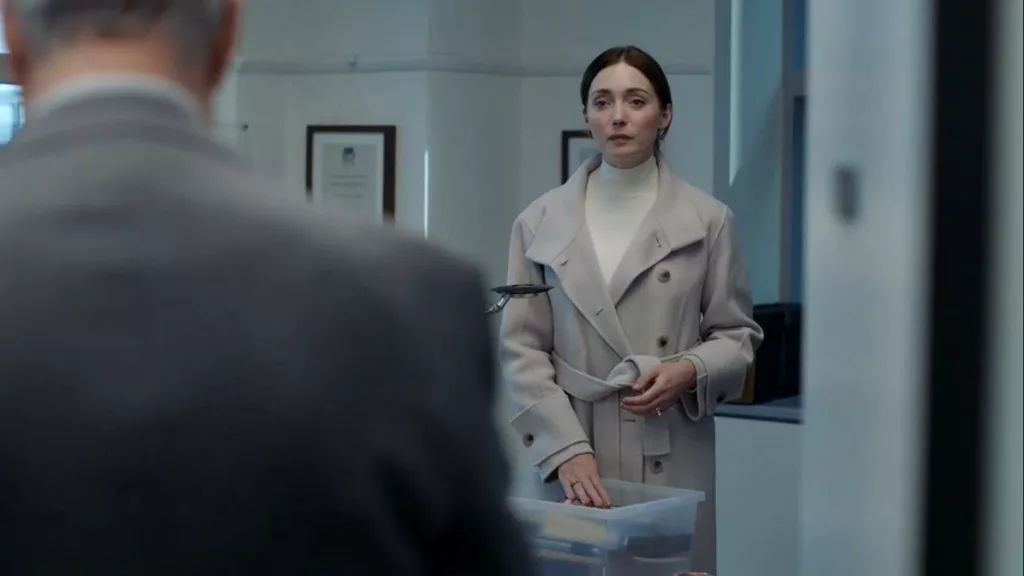Set in inner-city Melbourne, the gritty new SBS drama Safe Home offers an unflinching look at the crisis of domestic violence in Australian society. Centered around a fictional, underfunded family legal aid office that supports victims, we enter this tough world through the eyes of Phoebe, a passionate young lawyer played with nuance by rising star Aisha Dee. She leaves behind a high-powered law firm job to pursue more meaningful work, soon realizing just how broken the system is for vulnerable people suffering abuse behind closed doors.
As Phoebe settles into her demanding new role assisting victims, the show reveals she also carries complex personal baggage tied to inappropriate behavior from her past firm. Through evocative editing shifting across timelines, we gradually uncover a possible tragedy tied to a domestic violence court case. So while framed as a character drama, Safe Home brings pulse-quickening suspense painting its setting as an often cruel city for those slip through society’s cracks.
Yet despite confronting traumatic scenarios head-on, the show carefully avoids trivializing the agony of family abuse. There’s a journalistic attention to detail in capturing system failings, but creator Anna Barnes equally spotlights resilient people supporting victims. So brace yourself as this thriller pulls no punches, but trust that Safe Home ultimately tells vital stories in a responsible, compelling way. Its steadfast humanity might just give you hope.
Shifting Timelines Slowly Untangle Secrets
Rather than unfold Safe Home’s narrative in simple chronological order, creator Anna Barnes opts for a more challenging structure jumping back-and-forth across three key time periods. This editing approach mirrors the fragmentation abuse survivors face, suggesting that linear logic fails grasping this trauma. While initially confusing, sticking with the show lets Barnes rewardingly weave together a cohesive societal tapestry spanning law firms, legal aid offices, and police stations.
We first meet passionate lawyer Phoebe on her last day working at a corporate firm before shifting to her eagerly starting a new role at Melbourne’s Family Violence Legal Service. The contrast is stark – her slick office filled with ambitious lawyers is swapped for a cramped, chaotic setting where dedicated advocates like prickly Jenny help domestic violence victims free of charge. Already we get a sense of this show’s mission giving voices to those often unheard.
From here, the storytelling simultaneously fills in two key strands – Phoebe’s uncomfortable past working under a sexually inappropriate senior partner, plus police questioning her about a recent suspicious death tied to someone in an abusive relationship. Brief stylistic flashes cue us that these events already occurred, building mystery about what chain of events led to Phoebe seemingly now implicated in a complex investigation.
Within this framework, each new episode introduces another case study of an abuse survivor failed by systems meant to protect them. For instance, isolated rural wife Diana faces worsening psychological torture from her controlling husband in episode one before being pushed over the edge. Barnes pointedly keeps the violence off-screen, instead building tension through implications and Diana’s rising panic. It’s just one example of how oppression takes many forms beyond physical brutality.
As purposeful as the time-hopping structure is for tone, some critics argue it creates needless confusion distracting from the show’s vital message. Character motivations around Phoebe’s questionable decisions at times do remain vague until latter episodes clicked into place. But patience with this daring narrative format ultimately delivers profound emotional rewards.
In dramatizing cycles of violence the legal center continually confronts, Safe Home calls into question usual dramatic conventions. Should we anticipate a typical story arc after introducing unresolved mysteries and high stakes? As with clients left anxiously unsure what tomorrow might bring, here the future remains tenuously unclear for all major players. Such precariousness permeates the inner urban environment depicted on-screen, reflecting the instability victims face.
So while satisfying plot payoffs arrive eventually, Barnes never loses sight of the persisting injustice enabling these traumatic tales. Echoing activists tirelessly tackling the problem daily, the show’s radical act lies in centering survivors’ perspectives and resilience amidst fragmented story threads. Piece together their experiences, Safe Home urges, and a larger truth emerges exposing systemic cruelty that must be remedied through collective action. This bold narrative approach ensures the revealing drama impacts well beyond merely thrilling us.
“Immerse yourself in the intense drama of ‘Double Down South’, a film that blends sports, western, and thriller genres into a gripping narrative. Explore our Double Down South Review to delve into this unique cinematic experience that masterfully explores gender, race, and the complexities of human nature. Click here to discover why this gritty genre experiment is a must-watch.”
Spotlighting Hidden Crisis of Family Abuse
Rather than sensationalize domestic violence for cheap thrills, Safe Home courageously confronts the endemic crisis head-on. Matching the exhaustion of frontline workers, the drama pulls no punches capturing harrowing stories affecting countless Australian families behind closed doors. But creator Anna Barnes equally avoids despair, balancing hardship with heart.
While one woman is physically attacked on-screen, more often oppression takes less visible forms like financial control or social isolation. We feel the creeping dread as persona non grata Diana has bank cards cancelled by her rural husband, mirroring how vulnerability snowballs incrementally. Through such nuanced portraits spanning socioeconomic backgrounds, Barnes deftly articulates domestic abuse’s complexity beyond reductive stereotypes.
Through Phoebe’s fish-out-of-water experience, we witness good people worn down by trauma exposure bringing pessimism, despite their dedication. Her colleague Jenny builds emotional armor after years handling abuse cases, fiercely protecting herself to keep advocating for clients against terrible odds. This balance between empathy and hardness, stress versus satisfaction in fighting injustice, is thoughtfully conveyed.
Indeed, the show suggests society narrowly defines family violence as dramatic incidents rather than an insidious pattern of mistreatment eroding dignity over months and years. Friends and family often miss warning signs something is amiss, especially with oppressors concealing cruelty behind friendly public facades. Safe Home argues only confronting the scale of suffering – one in six Australian women face abuse by an intimate partner – can spark change.
In articulating survivors’ frustrating struggles, the series highlights huge service gaps and systemic barriers preventing their protection. Police and social workers are shown blaming victims, while Australia’s underfunded legal assistance sector cannot meet community need. Reforms promoted include more trauma-informed frontline training and boosted crisis accommodation to prevent homelessness.
These shortcomings hit marginalized groups hardest, so the show celebrates the legal center’s diversity. Rainbow flags fly proudly, people with disability and interpreters serve key roles, while Jenny represents fierce Asian women. Amongst clients, strong First Nations and migrant representation reminds how poverty compounds vulnerability. Still, moments of shared laughter remind no one is defined solely by their disadvantage.
Such considered handling prompts praise for how Safe Home sidesteps gratuitous imagery to enlighten audiences on trauma’s true impacts. The show tackling complex social issues around abuse is executed with compassion, not anger or pedantry. Like case worker Phoebe, we’re educated on problems to spur overdue action.
Compelling Portraits of Resilience
As our gateway into Safe Home’s confronting realm, communications specialist Phoebe compellingly evolves from naive newcomer to fiercely determined advocate. Australian actress Aisha Dee draws praise for her portrayal tracing Phoebe’s dawning awareness of domestic abuse’s prevalence. Though she never faced such trauma personally, glimmers into inappropriate workplace behavior she endured demonstrate injustice takes many forms. We watch her passion for justice grow, willing to take great personal risks.
In homeless victim Diana, performer Janet Andrewartha crafts an excruciating portrait of someone psychologically worn down by long-term oppression. Though initially wary of intervention, remembering happier early days makes her situation clearer as abusive patterns escalated insidiously. We will Diana to escape her detached husband’s airless grip, making her representative of countless cases where love curdles into life-threatening control. She finds courage speaking out.
As Phoebe’s boss Eve, Virginia Gay expresses the weary frustration of someone who cannot comprehensively help traumatized people with continually inadequate resources. Craving political support that never arrives, she gets hardened by the endless task yet perseveres for clients. Meanwhile lawyer Jenny, played by Mabel Li, illustrates that lingering emotional impacts hit frontline staff too, not just victims. Her prickly manner shields profound empathy.
Interestingly, the show avoids framing domestic violence as solely a women’s issue. Phoebe’s tense dynamic with corporate lawyer Julian explores how toxic masculinity and power imbalances permeate professional settings too. Their ambitions blinded them to doing right by vulnerable colleagues, recognizing belatedly that looking away enables abuse.
As quintessential Melbourne characters move from shadowy high-rises to leafy suburbs, each challenges assumptions domestic abuse only affects certain groups. United by trauma’s legacy, they balance harrowing scenarios with a dogged refusal to remain silent any longer.
Female-Led Crafting Brings Stories to Screen
Safe Home announces itself as a series taking representation seriously both behind and in front of the camera. Rising playwright Anna Barnes draws from her legal aid experience crafting the distinctly female-focused narrative. Joining award-winning producer Imogen Banks behind the scenes, they assembled impressive talent to steer this project thoughtfully.
Acclaimed director Stevie Cruz-Martin (The Tailings) leads filming with cinematographer Eloise Ross capturing Melbourne streets starkly. Chilly cityscapes externalize the isolation victims contend with, the facade of order barely masking trauma roiling beneath. Yet glimmers of warmth consistently emerge in intimate shots profiling resilience.
Moreover, Banks proudly engaged Heads of Department that were overwhelmingly women, actively addressing filmmaking’s longstanding diversity problems. The crew consequently better understood sensitively portraying difficult scenarios around intimate partner violence. They demonstrate how nurturing an inclusive environment allows creatives from diverse backgrounds to excel telling shared human stories.
With actor safety requiring extreme care staging violent scenarios, intimacy coordinator Adele Vuko proved invaluable. Vuko sensitively choreographed physically and emotionally charged sequences to protect stars like Aisha Dee, who leads as lawyer Phoebe with an incredibly raw presence. The cast uniformly praised how protocols ensured the heavy subject matter felt a collaborative creative process rather than traumatic burden.
Particularly as family abuse worsens during COVID-19 lockdowns, this creative coalition recognized presenting such social issues compellingly held real responsibility. Barnes openly hoped to increase public understanding and sector funding by vividly capturing experiences routinely dismissed and belittled behind closed doors.
Rather than graphic content, she lets troubles simmer in subtext – and Melbourne’s winter chill – with cast’s nuanced looks saying enough. So while filler scenes might have heightened melodramatic danger, Safe Home groups women creating and starring to emphasize what goes unspoken. The result stands tall as a TV achievement modeled on gender equality behind-the-scenes and on-screen representation to match themes calling out oppression.
Spotlighting Agony While Affirming Humanity
Given Australian television’s tendency to favor rose-colored storytelling, Safe Home stands out for frankly confronting domestic trauma haunting countless neighborhoods. Far from relying on Hollywood dramatics that might cheaply exploit suffering, this thriller employs a journalistic gaze that respectfully humanizes those impacted. It proves engaging drama can illuminate societal problems without condemnation. Nuance in characterization avoids reducing people to simplistic villains or victims.
While certainly unrelenting spotlighting systemic shortcomings, creator Anna Barnes sprinkles in redemptive moments underscoring that situations can improve through understanding and care. Counselors listen compassionately, legal experts provide lifelines, friends offer refuge – despite limited resources, kindness glimmers. Although focusing specifically on Melbourne, such quiet heroism surely exists everywhere.
Moreover, survivors refuse being wholly defined by their oppression. Resilient mother Diana maintains everyday routines like gardening amidst escalating danger, hinting at an identity beyond current crisis. Given financial instability and other constraints often trap victims, these portraits emphasize that freedom ultimately resides in our perceive personal agency. Even if options seem limited, we each can take some control.
Through nonlinear editing fracturing conventional narrative, Barnes further conveys how trauma fragments one’s sense of place in the world. Past and present blur for those enduring abuse, especially when institutions fail protecting them. By compellingly immersing us in their precarious state through interviews and flashbacks, we gain experiential understanding of why speaking out proves so hard. Fear and self-blame hinder, despite wanting better.
Some critics argue this daring, disjointed style creates needless viewer confusion. Indeed, initial episodes unfold like a disorienting nightmare. Yet as character motivations crystallize, the show’s bold form mirrors life for those navigating domestic volatility. Sticking through unease, the storylines ultimately clicked for me in an eye-opening way.
What stays with you is how oppression often accumulates through creeping small actions, not singular events – analogue to the frog boiled slowly. We must learn recognizing abusive patterns sooner, improving support structures that encourage safely seeking help early. For Phoebes and Dianas everywhere, time is of the essence. May series like Safe Home prompt us asking questions, before it’s too late.
Courageous Storytelling Makes Lasting Impression
While too often ugly reality gets sanitized on-screen into digestible tropes, Safe Home distinguishes itself tackling the confronting domestic violence crisis with responsibility and heart. Wisely avoiding graphic content that might exploit trauma for flashy thrills, creator Anna Barnes instead crafts an empathetic call to action. Backed by Aisha Dee’s stunning performance as steely advocate Phoebe, this SBS production makes space for survivors’ stories largely ignored by society.
Given the project’s heavy subject matter, it carries weighty expectations to get the message right. By investing care with an inclusive female-led crew, Safe Home resonates as authentic plus eye-opening without turning overly grim. Beyond highlighting systematic failings that demand addressing, Barnes balances darkness with hope as battered characters summon tenacious strength. Production flourishes like Eloise Ross’ evocative Melbourne cinematography externalize inner turmoil, with intimate shots spotlighting sparks of resilience.
While certainly demanding viewing, the show manages to enlighten audiences on abuse’s nuances without excessive heavy-handedness. We organically gain comprehension by walking in complex personalities’ shoes, anchored by Dee’s compelling presence. She signals that well-meaning individuals like Phoebe could arise in any workplace to champion positive change.
By thoughtfully dramatizing endemic injustice behind closed doors, Safe Home makes clear Australia must support victims better while preventing domestic violence altogether. This climactic cry for cultural shift cements the production as a signature achievement for Australian television – one that will hopefully empower movements protecting vulnerable people everywhere. Unquestionably hard to watch at times yet impossible to ignore, its courage respects reality’s messiness.
The Review
Safe Home
Through bold performances and storytelling choices refusing to soften harsh realities, Safe Home brings an often invisible crisis agonizingly close. The novelistic richness of Barnes' fractured structure risks occasional confusion, yet ultimately rewards as character motives crystallize across a compassionate societal cross-section. Impressively grounded without descending into hopelessness, this shattering call for justice introduces indelible voices that viewers won't soon forget.
PROS
- Powerful lead performance by Aisha Dee
- Directing and cinematography effectively create an atmosphere of dread
- Nuanced exploration of different forms of domestic abuse
- Gripping nonlinear structure that comes together
- Timely commentary on failures supporting vulnerable people
CONS
- Initial disjointed storytelling confusing to some viewers
- Supporting characters less developed than lead
- Heavy subject matter could be triggering for some audiences





















































